The Camino de Santiago, or the Way of St. James, is an epic Catholic pilgrimage to the Spanish city of Santiago de Compostela, where St. James the Greater’s remains are thought to be located. The hike isn’t only for the pious, however. While there are many religiously significant stops along the way, a wide array of international trekkers enjoy the pilgrimage route every year.
The Camino is actually a network of trails, and its most popular route, the Camino Francés, spans from the city of Saint-Jean-Pied-de-Port at the base of the French Pyrenees to Santiago de Compostela in northwestern Spain.
The trail has been walked since the early ninth century, hosting kings and queens, Roman armies and legions of Catholic pilgrims, but in recent years it has attracted an increasingly diverse crowd. After a brief dup during the early days of COVID-19, over 446,000 hikers, known as “peregrinos,” or pilgrims, completed the trek to Santiago in 2023. If anything, the right of passage has gained popularity since the start of the coronavirus pandemic, as travelers and hikers alike are reprioritizing their health and wellness. The New York Times even declared 2023 “The Year of the Long Walk.”
“People are drawn to the Camino because of its staying power,” says Beth Jusino, author of Walking to the End of the World: A Thousand Miles on the Camino de Santiago. “Walking the Camino is a chance to intentionally slow down and move at a human pace, to join a history that’s so much bigger than any of us individually.”
Crossing the rugged Pyrenees and spanning undulating plains before winding through lush hillsides, the Camino de Santiago is a unique window into the Iberian Peninsula’s historical, natural and cultural beauty. All that said, if you’re planning to tackle the Camino de Santiago, there’s a lot to keep in mind, like logistics, places of interest and finding the best route for your budget, time frame and fitness level. In this guide, we’ll cover:
Why Hike the Camino de Santiago?
Everyone has a different reason for embarking on the Camino de Santiago, and here lies the trail’s unavoidable appeal. For many, the Camino is the trip of a lifetime—a 500-mile journey through some of Europe’s most beautiful landscapes. For others, the sense of self-discovery and achievement that a walk along the Camino can bring offers an undeniable allure. Yet for all, the extended stretch of incredible food, beautiful historic sites, fantastic beer and wine, and camaraderie are what make the Camino de Santiago one of the most legendary hikes in the world.
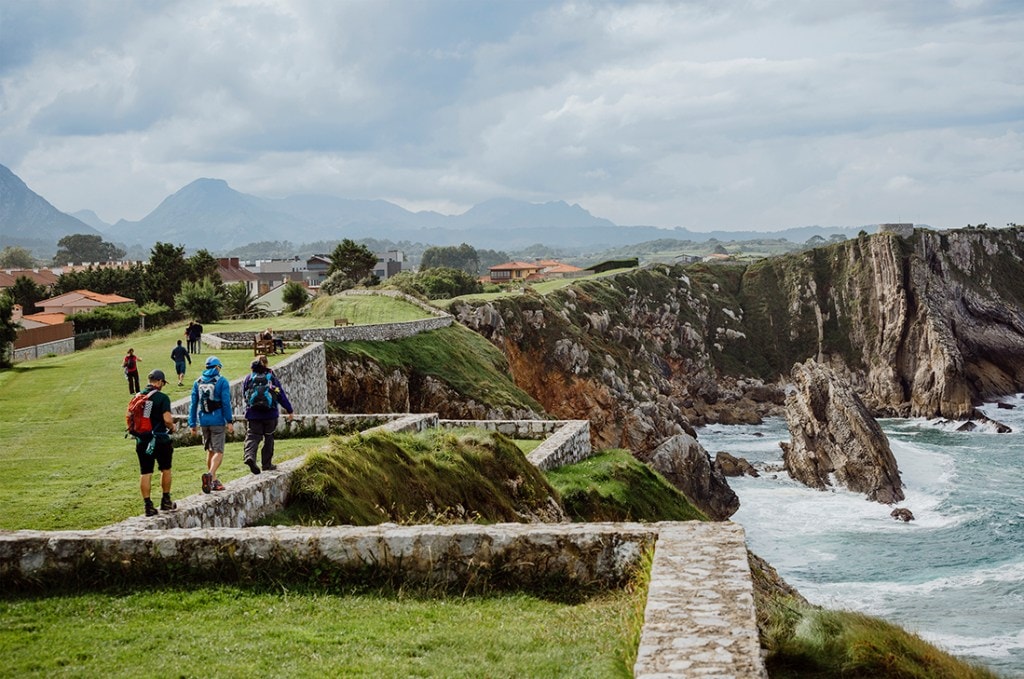
Multiple routes of the Camino de Santiago hug the rugged Atlantic coastline. Here, pilgrims balance between land and sea on the Camino del Norte.
“The Camino is a unique blend of physical challenge and cultural holiday,” says Jusino. “It’s more than simply hiking for sport. You become part of a community from all around the world who come together for a shared purpose, and those [people] quickly start to feel like family.”
With its ample resources and local support systems, the Camino is a trail for hikers of all skill levels, ages, genders and travel experience.
What Are the Routes?
Camino Francés: Although it’s often confused as the one and only Camino de Santiago, the Camino Francés (the French Way) is certainly the most popular travel option, with over 60% of pilgrims following this route. The Camino Francés starts in Saint-Jean-Pied-de-Port on the French side of the Pyrenees, and crosses sizable mountains (check the weather), open plains and lush hills on its way to Santiago de Compostela. This route has a well-established system of albergues (inns and lodges built for pilgrims), lots of food options and locals used to international thru-hikers.
For a prepared and experienced hiker, this route takes about 30 days start to finish, covering nearly 500 miles. Keep in mind that the Camino Francés receives the most foot traffic, meaning there’s plenty of opportunity to meet other pilgrims, but also a fair share of crowds during much of the year.
Camino del Norte: Winding its way along the verdant north coast of Spain, the Camino del Norte starts in the border city of Irún before passing through Bilbao, Santander and Oviedo. The path is accentuated by dramatic coastal cliffs, rugged mountains and tiny fishing villages.
Although the route passes through major cities, there are fewer accommodations along the Camino del Norte, meaning pilgrims are advised to stick to a schedule and more detailed plans ahead when possible.
Stretching 500 miles over hilly terrain, this northern trek typically takes 35 days for the seasoned hiker.
Camino Portugués: The only recognized route to start from Portugal, the Camino Portugués (the Portuguese Way) is also the easiest option, following relatively flat—but gorgeous—terrain from Lisbon to Porto and up into Spain. A popular route is to start in Porto and make your way north, hiking along rugged Atlantic coastline and forested highlands.
Starting from Lisbon, this Camino stretches over 390 miles. Be aware, much of this section connects via motorways (road walking).
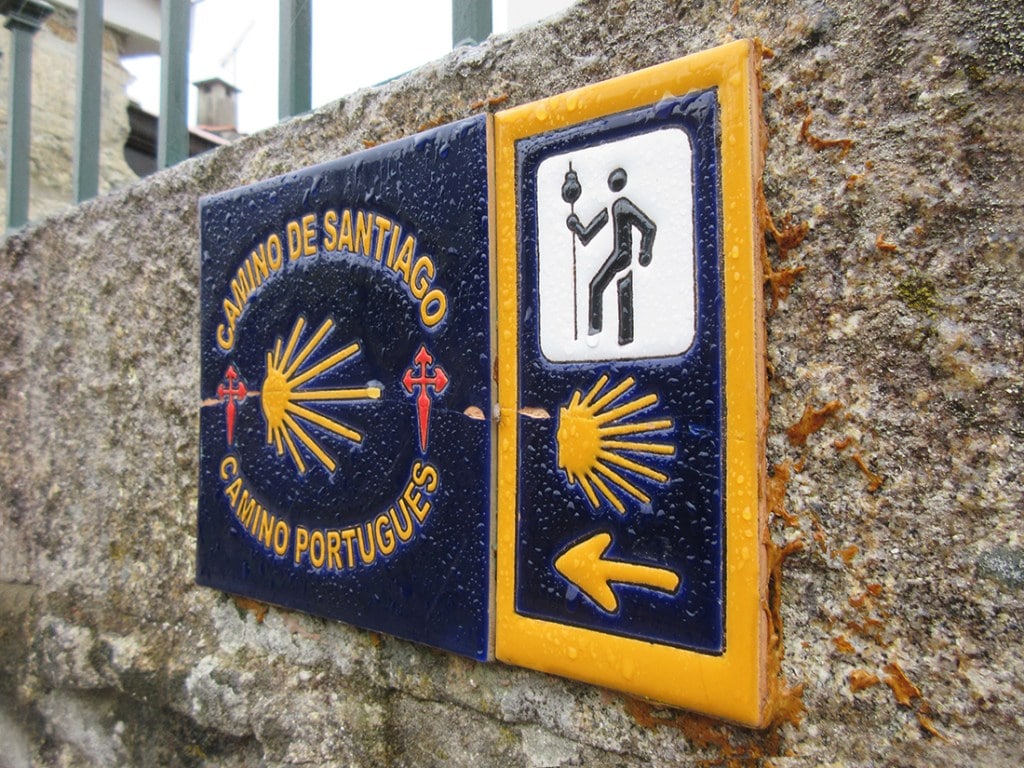
Many sections of the Camino de Santiago are marked with signs bearing the iconic Scallop Shell. Here, hikers are directed along the Camino Portugués.
Via de la Plata: At 620 miles long, this hike is the longest through Spain, following an old Roman road north from Seville to Santiago de Compostela. The route, which passes through Mérida, Cáceres, Salamanca, Zamora and a slew of other Spanish cities, is highly recommended for history buffs looking for a different kind of adventure: The Via de la Plata shows off Spain’s rich history of Moorish and Roman architecture, art and more.
Camino Inglés: The shortest of all the traditional pilgrimageroutes, the Camino Inglés (the English Way) is a Y-shaped route which can be started in either La Coruña or Ferrol, in Spain’s northwestern Galicia region.
Starting from La Coruña, the Camino Inglés only measures 46 miles, too short to earn you a Compostela (hikers must complete over 62 miles to receive an official certificate of completion from the Pilgrim’s Office in Santiago de Compostela).
If you start the route in Ferrol, however, you’ll earn your certificate, as that one covers 70 miles, usually done in five days.
Camino Primitivo: A spur off of the Camino Francés, the Camino Primitivo (the Original Route) is a popular detour for pilgrims interested in visiting Oviedo’s impressive cathedral. The path is the most direct route from Oviedo to Santiago de Compostela and reconnects with the Camino Francés about 40 miles outside of Santiago.
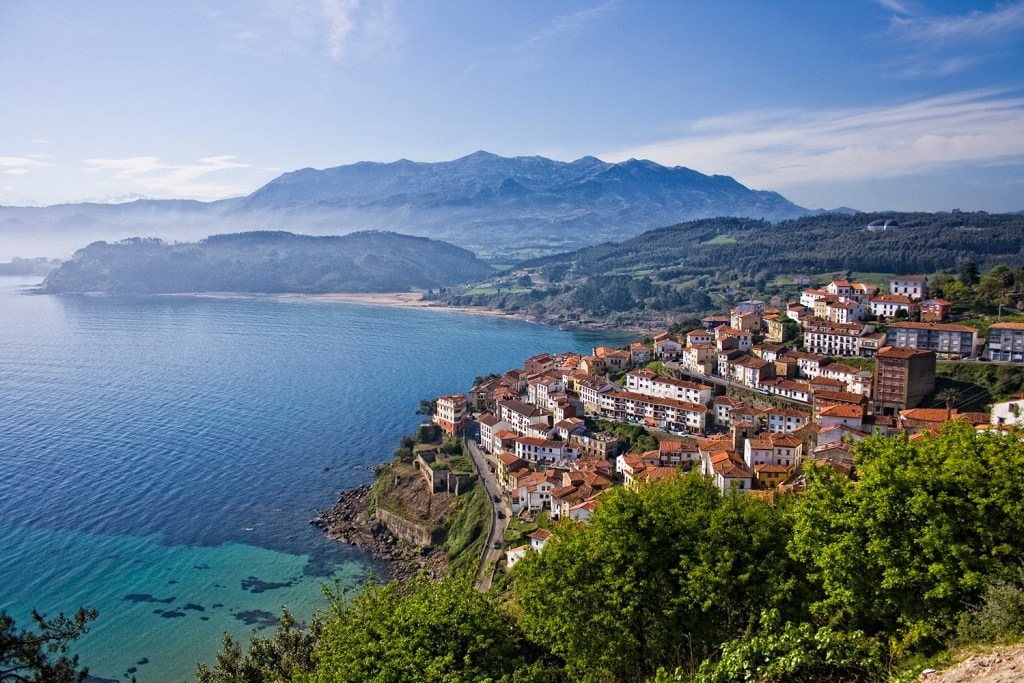
The fishing village of Lastres, a town north of Spain on the shores of the Bay of Biscay, in the autonomous region of Asturias.
Passing through the mountainous terrain of Asturias, this 200-mile walk (from Oviedo) is not for the faint of heart or the weak of leg, as hill climbing through rough weather is all but guaranteed—even in summer months. Still, if you have a little left in the tank, this is a stunning detour.
Camino Finisterre: For some pilgrims, the Camino doesn’t end in Santiago de Compostela. Instead, many hikers continue their trek an additional 55 miles to Finisterre, a rockbound peninsula that literally translates as “the end of the world.” Here, pilgrims will be awarded an additional Compostela accreditation for their efforts.
How to Hike the Camino de Santiago
There is no perfect way to hike the Camino de Santiago, but knowing how the journey works before setting off can go a long way toward logging a successful trip. Here are a few things to keep in mind before setting off on your walk.
Albergues: These are pilgrims’ most common form of lodging along the Camino. Averaging 7 to 20 euro per night, these basic accommodations are run by churches, local governments, nonprofits and private groups, and offer up cheap beds in a variety of locations. Because they are designed specifically for pilgrims, albergues are a great place to meet new people on the trail or reconnect with trail partners throughout their journey.
Compostela: The “proof” you completed your Camino pilgrimage, the Compostela is a certificate that you receive at the end of your walk in Santiago. Compostelas are only awarded to those who have completed 62 miles or more on foot before reaching the Camino’s terminus at the Cathedral of Santiago de Compostela.
Tip: Get to the Pilgrims Reception office in Santiago de Compostela early. With so many pilgrims arriving in the city every day, lines can last hours and keep you from getting your official Compostela. (This is particularly a problem if you don’t have extra days in Santiago.)
Credentials: Known as “pilgrim passports,” (Credencial del Peregrino) these booklets are essential for hikers looking to certify their pilgrimage to Santiago de Compostela. Hikers must get a stamp in the booklet each day to present and verify their Camino at the Pilgrims Reception office in Santiago. Albergues, post offices, some churches and restaurants offer their own stamp, which you’ll receive each night.
Credentials also unlock a special pilgrim rate for lodging and food along the trail, so make sure to have them handy. For pilgrims from the U.S., the booklets can be purchased from American Pilgrims on the Camino (no membership required), or at shops and churches at the start of your trek.
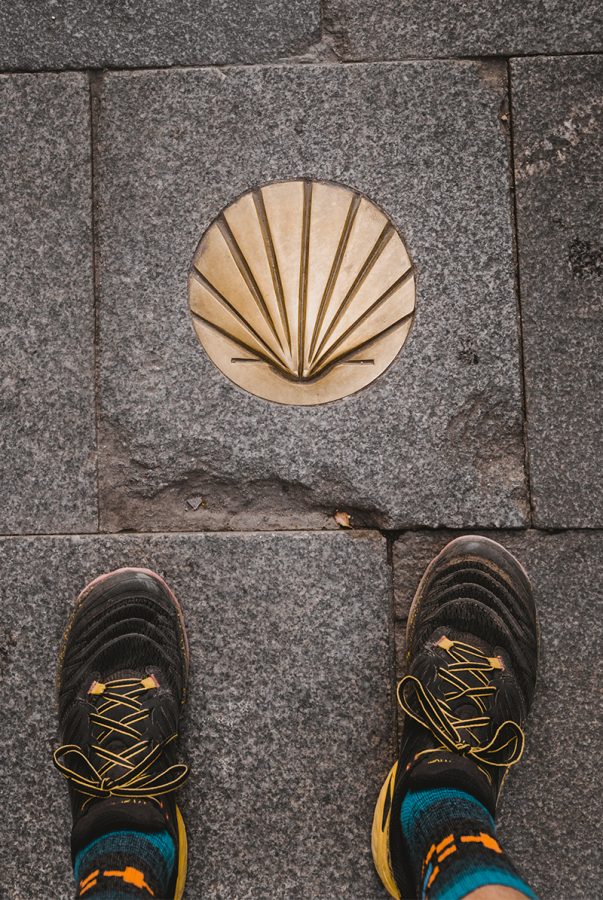
Lost? Look for the Camino’s Scallop Shell waypoint marker.
Tip: Although walking much of the Camino de Santiago is fairly straightforward, it’s possible to become disoriented. Fortunately, the Camino is peppered with the Scallop Shell symbol to keep pilgrims on track. If in doubt, look for this iconic waymarker.
Types of travelers: For many, the Camino starts as a solo event—an adventure in self-discovery and self-growth. While that may hold true for the duration of the trip, lots of pilgrims quickly find themselves forming unofficial groups along the trail, one of the special mixes of culture that makes the trek such a unique experience. These bonds of friendship may last for an evening or for the duration of the hike, as most travelers walk at a similar pace.
Top Stops on the Camino
Each day on the Camino is a new adventure, whether it’s discovering a small family-run restaurant or resting your head in the eaves of a 14th-century church. While some experiences will stick out above the rest, here are a few stops that can’t be missed along the Camino Francés.
Pamplona: Renowned for its San Fermin Festival, featuring the infamous running of the bulls, Pamplona is a relatively laid-back city for much of the year and a historical center for the Navarra region of Spain. Castle Square is the center of life in Pamplona’s Old Town, a collection of restaurants, shops and bars from which Ernest Hemingway penned The Sun Also Rises.
Logroño: The home of Spain’s famous La Rioja wine, Logroño is a must-stop for foodies. The city pairs its wine with some of the country’s tastiest tapas and provides visitors with streets and streets of delicious options sure to make you forget your aching feet for the evening. For atmosphere, make sure to check out Calle del Laurel.
The city also hosts the Rioja Wine Harvest Festival in late September, giving pilgrims a chance to witness the “treading of the grapes.”
Irache: One of the many surprises along the Camino, this small medieval town is a popular stop for food and wine. Its excellent garden-to-table tradition is topped off by the nearby Bodegas Irache, which maintains a communal wine spout free of charge for passing hikers.
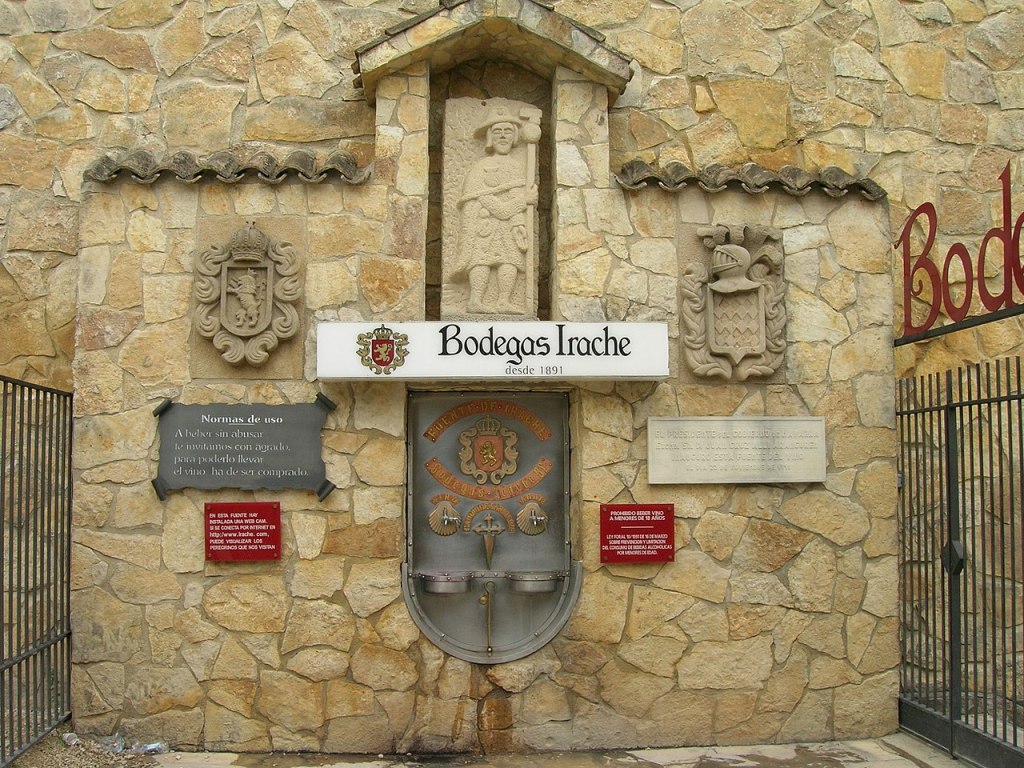
For passing pilgrims, libations flow freely at Bodegas Irache. (Photo Credit: José Antonio Gil Martínez under CC BY 2.0)
Burgos: Mixing old history with new, Burgos is home to the Cathedral of Burgos, a 13th-century Gothic masterpiece and UNESCO World Heritage site. Aside from the city’s rich cultural fabric, its promenade along the Arlanzón River and old, labyrinthine streets of restaurants and bars hold a uniquely Spanish charm. Burgos is particularly known for its cheeses and morcilla, Spain’s popular blood sausage.
León: León’s 13th-century Gothic cathedral is one site that cannot be missed along the Camino. The cathedral features a stunning array of stained-glass windows that create a mesmerizing light show in the church’s interior.
Like many of the stops along the Camino, León’s old town is composed of lively streets full of hidden eateries and local watering holes.
Planning Your Trip
Best Time to Visit
While the Camino de Santiago is passable all year round, April, May, June, September and October are the optimal months on the trail. For those opting for the popular Camino Francés, the Pyrenees mountain chain can see deep snow and inclement weather in wintertime. Also, a number of albergues close in winter due to low tourist traffic.
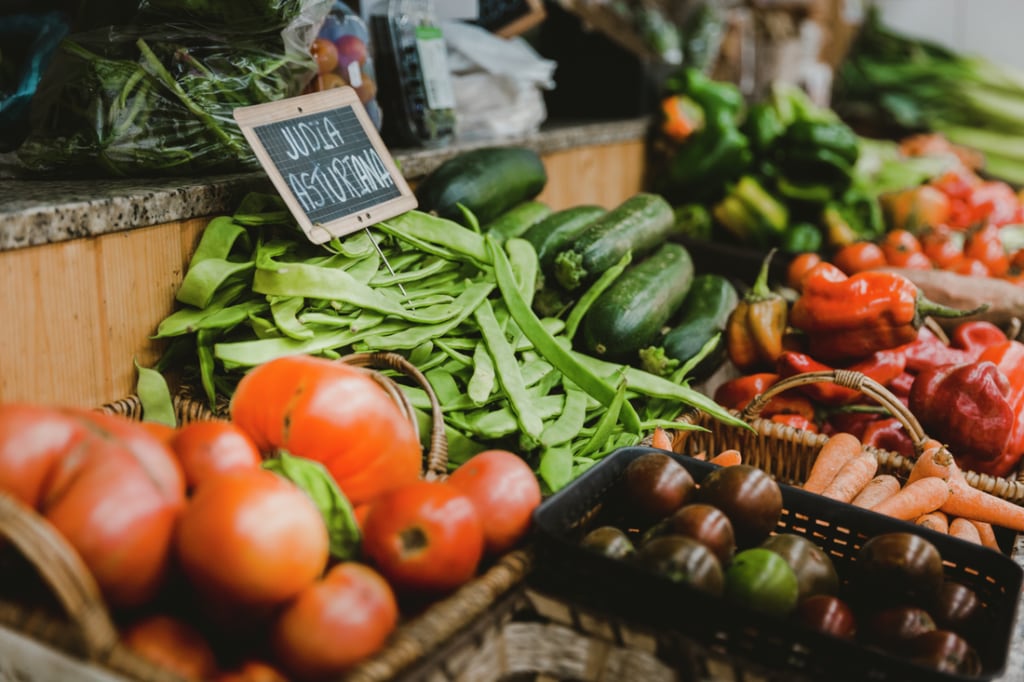
Hikers along the Camino have no problem finding fresh, farm-to-table fare during their pilgrimage.
Summer months are vacation season in Europe, meaning an influx of hikers on the trail and strained trail infrastructure (read: fewer available beds and less food). Additionally, summer temperatures across central Spain often hit 90 degrees in July and August. Over the last few years, the country has suffered historic summer heat waves reaching its highest recorded temperature in 2021: 188 F near Cordoba.
In contrast, shoulder seasons in the spring and fall feature much more enjoyable weather and far less foot traffic. Remember to note Spain’s Semana Santa holiday between Palm Sunday and Easter Sunday, as many pilgrims try and align their trips with this spring holy week.
How to Prepare
The Camino features very little in the way of technical terrain, making it accessible to many age groups and ability levels. However, what it lacks in technicality it makes up for in distance, and hikers should be accustomed to walking for multiple hours, many days in a row. Training can start small, with hourlong walks around the neighborhood, and increase to multiple-hour walks and hikes over a period of a month or longer. This is also an excellent time to break in trail shoes.
(Related reading: How to Train for Hiking)
What to Pack
Footwear: This is the most important piece of gear for your trip on the Camino, and also the most personal. Everyone’s feet are different, and those differences become even more evident over several hundred miles of walking over uneven terrain. Assess your own needs, whether that be arch support, breathability, weight—or a host of other factors—and keep in mind what time of year you’re making the trip (during wet or dry season, in the heat, or in potentially snowy conditions, for example).
Jusino recommends putting your shoes to the test well before hitting the trail, walking a few miles at a time with a weighted backpack, for several days in a row. Learn more with How to Choose Hiking Boots.
Quality hiking socks: Right in line with your footwear, a few good pairs of socks can make a huge difference over long distances. Where thick hiking socks can cause sweating and blisters, a thin to midweight sock paired with a moisture-wicking liner tends to be the most popular choice for pilgrims.
For those who are prone to blisters, liner socks help manage moisture and prevent the skin-on-skin friction that causes blistering. Read more in How to Choose Hiking Socks.
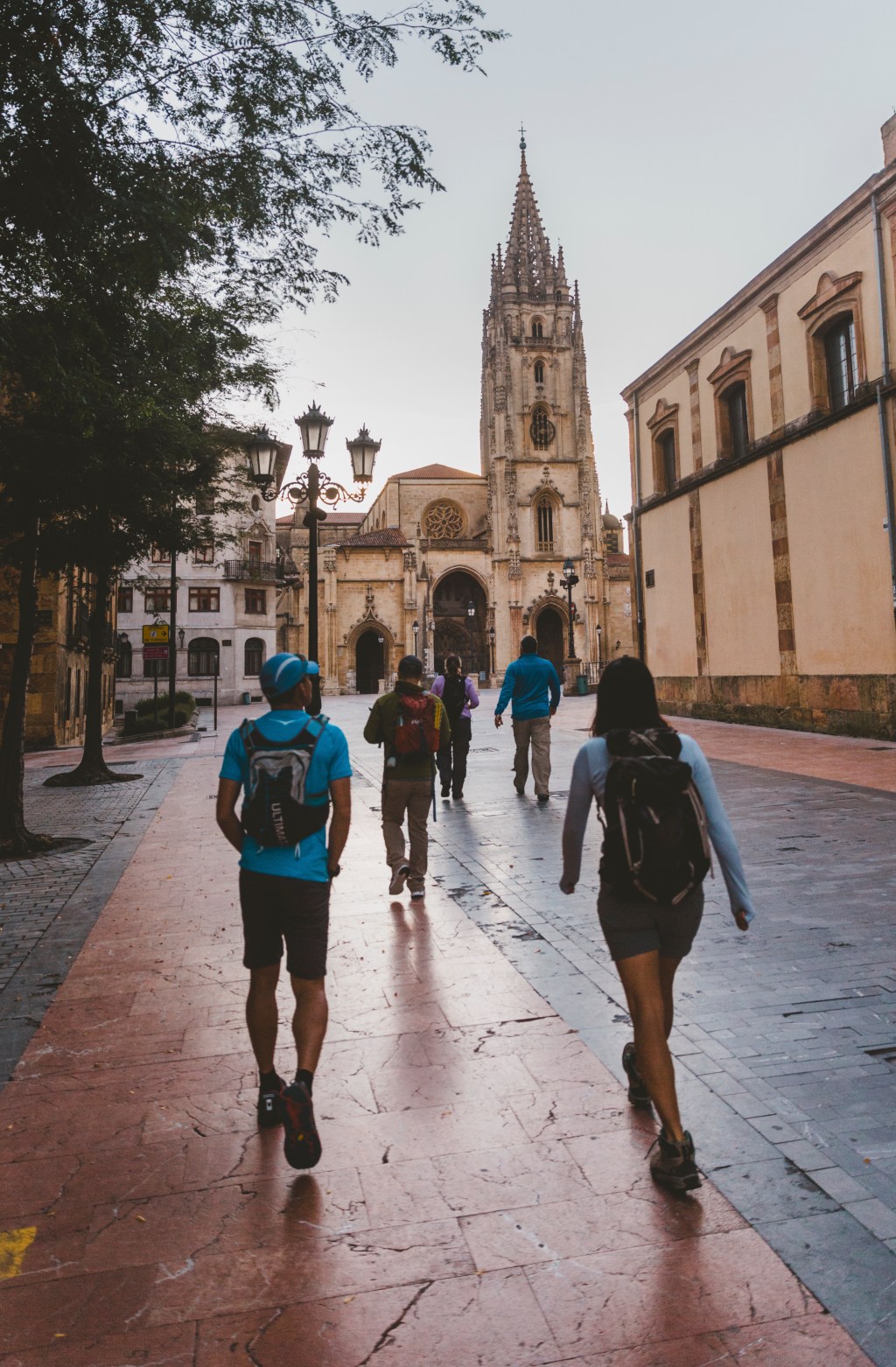
Pilgrims on the Camino Primitivo visit the Cathedral of San Salvador in Oviedo, Spain.
Durable underwear: Every layer on the Camino counts, even your undies. Avoid uncomfortable chafing with boxer briefs for men and a bikini cut underwear for women (with lightweight, moisture-wicking material, if possible). In this instance, comfort and performance go hand in hand.
Base layers (male)(female): Wandering from alpine passes to hot plains and wet hillsides, the Camino is a delicate dance in layering. Regulating body temperature is a constant battle along the trail, and base layers play a key role. Cotton and down do not typically thrive on the trail, but lightweight wool, fleece and synthetic base layers tend to fare much better. Plus, these materials can be easily washed in a shower at night and be dry by morning.
These layers paired with quick drying hiking leggings or hiking pants will form the core of your Camino wardrobe. Learn more with How to Choose Base Layers.
A hiking backpack you can trust: Your pack will be your closest companion on the Camino, up to 12 hours a day, 30-plus days straight. As a result, you need to choose a backpack that fits well and is practical for your hiking style. Typically, that means lots of external pocket room for snacks, water and things you’ll need throughout your day, like a phone or camera.
A 40-liter backpack should be more than enough for everything you’ll need, but remember the old Camino rule: Keep your pack as close to 10% of your body weight as possible. This may seem light, but every pound on your back will get heavier each mile you go. Light packs equal happy hikers. Learn more about How to Choose a Backpack and How to Size and Fit a Backpack.
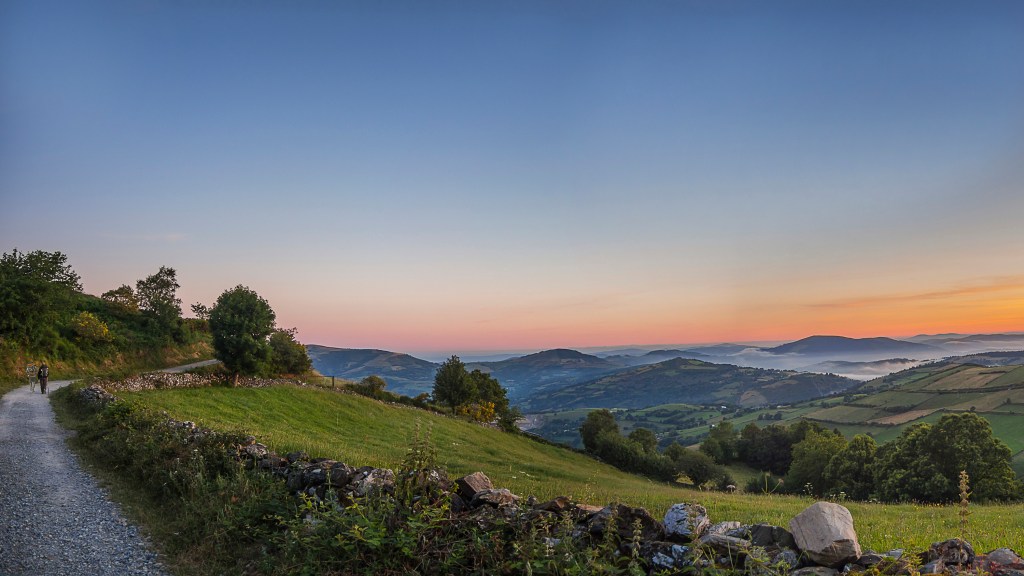
Much of the Camino de Santiago winds through rolling, pastoral countryside.
Shower bag: One of Jusino’s Camino hacks is a lightweight, waterproof shower bag with a hook, which can make the trail-shower experience much more enjoyable. (Many hostel showers do not have shelves or dry places to keep your stuff.)
Keep toiletries to a minimum, as you carry everything you bring on your back. In fact, many hostels will have a surplus of toiletries, discarded from hikers learning this lesson the hard way.
Travel Journal: Want to remember the Camino? Jusino recommends bringing a journal and taking trail notes for 15 minutes every night before bed. By the end of the trip, those small memories form a much larger, and lasting, story.
Key Phrases to Know
Good morning/Good day: Buenos días
How much does it cost?: Cuanto cuesta?
Where is the trail?: Donde está el Camino?
Happy trails! (a customary greeting throughout your time on the Camino): Buen camino.
